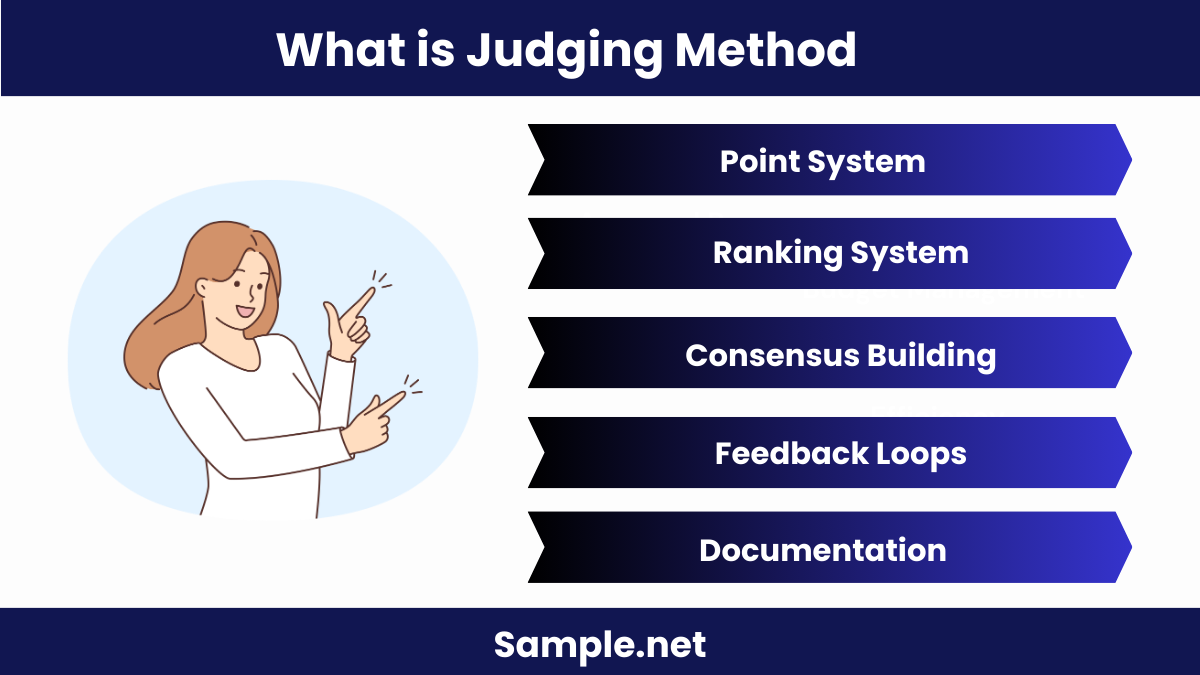Judging Score Sheet Samples
-

Judging Score Sheet Template
download now -
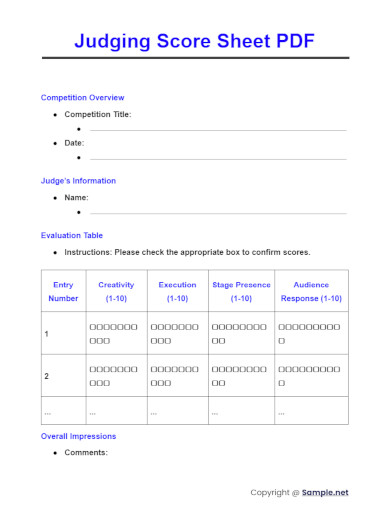
Judging Score Sheet PDF
download now -
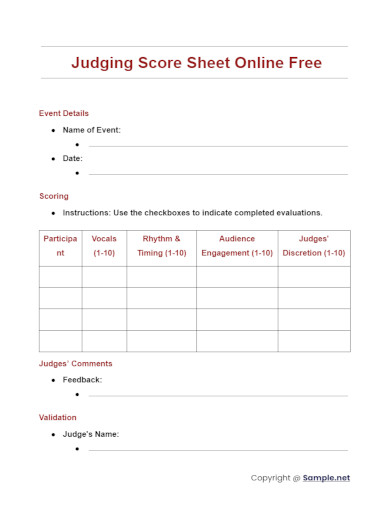
Judging Score Sheet Online Free
download now -
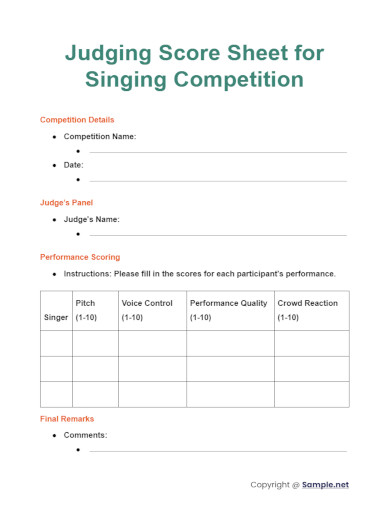
Judging Score Sheet for Singing Competition
download now -

Sample Judging Score Sheet
download now -

Poster Presentation Judging Score Sheet
download now -

T-Shirt Judging Score Sheet
download now -
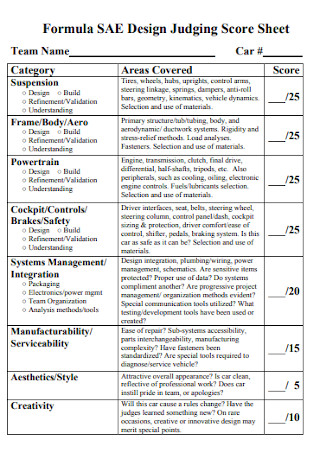
Sample Design Judging Score Sheet
download now -
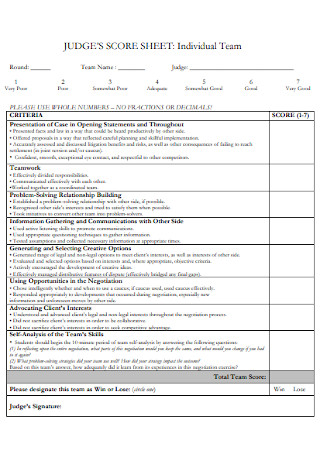
Dance Team Judges Score Sheet
download now -
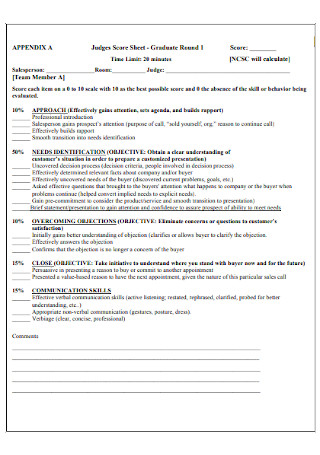
Graduate Beauty Peagent Judges Score Sheet
download now -
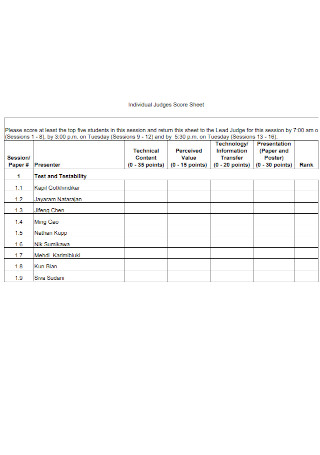
Cheerleading Judges Score Sheet
download now -

Sample Spelling Bee Judges Score Sheet
download now -
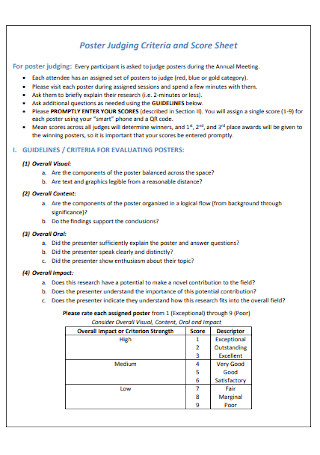
Poster Judging and Score Sheet
download now -
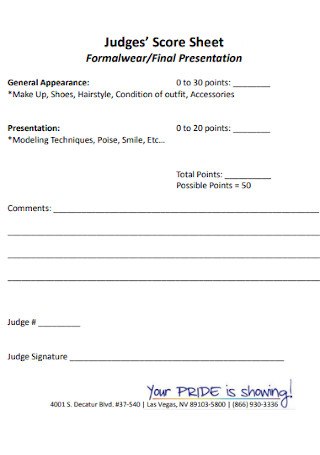
Singing Judges Score Sheet
download now -

Talent Judging Score Sheet
download now -
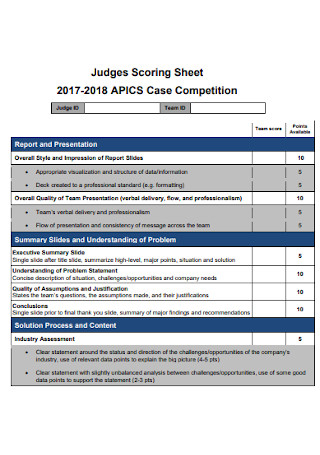
Story Telling Competition Judges Scoring Sheet
download now -

Judges Score Card Sheet of Gymnastics
download now -
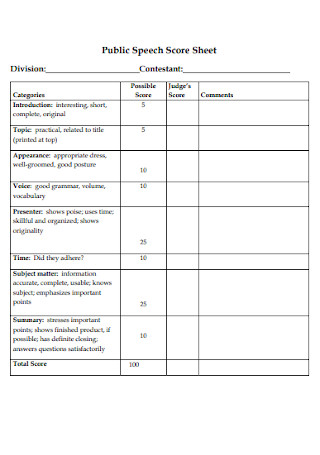
Judging Speech Score Sheet Format
download now -
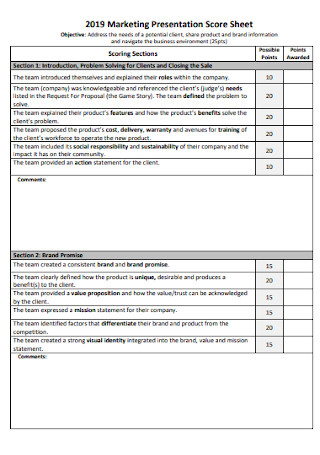
Marketing Judging Presentation Score Sheet
download now -

Kids Audition Judges Score Sheet
download now -
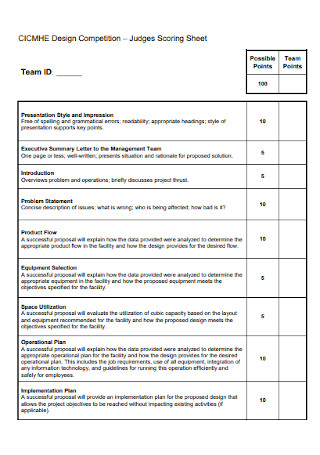
Design Competition Judges Scoring Sheet
download now -
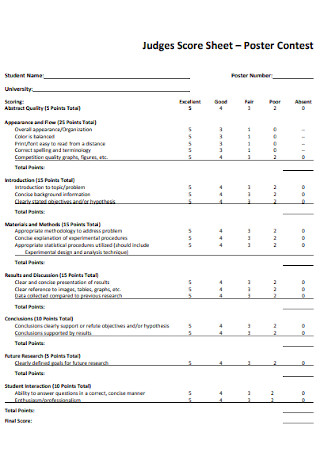
Judges Contest Score Sheet
download now -
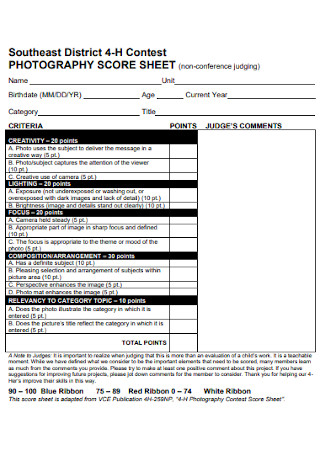
Photography Judging Score Sheet
download now -
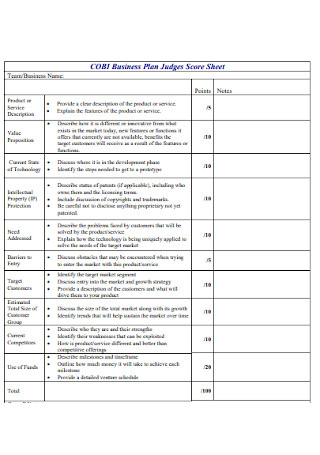
Business Plan Judges Score Sheet
download now -
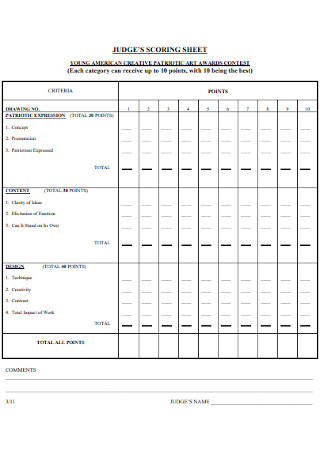
Judging Score Sheet Format
download now -
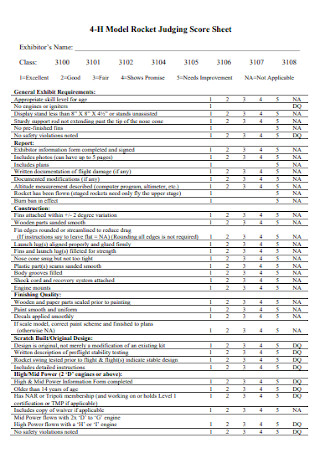
Model Rocket Skit Judging Score Sheet
download now -
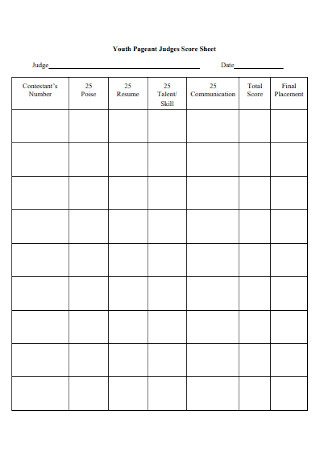
Youth Pageant Judges Score Sheet
download now -
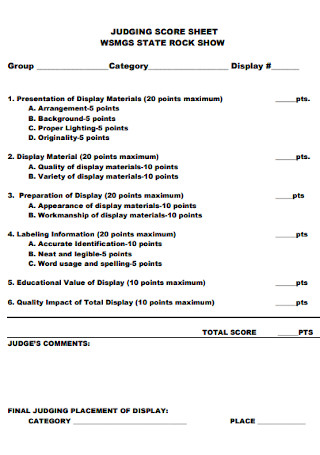
Show Judging Score Sheet
download now -
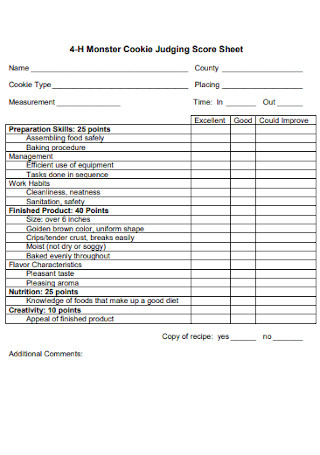
Cooking Judging Score Sheet
download now -

Science Exhibition Judging Score Sheet
download now -
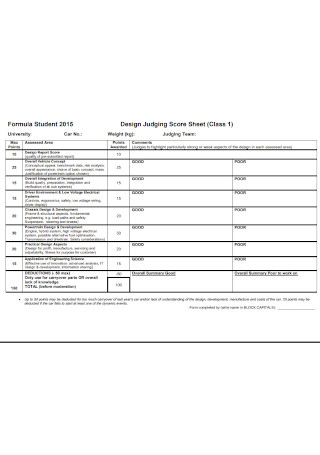
Design Judging Score Sheet Example
download now -
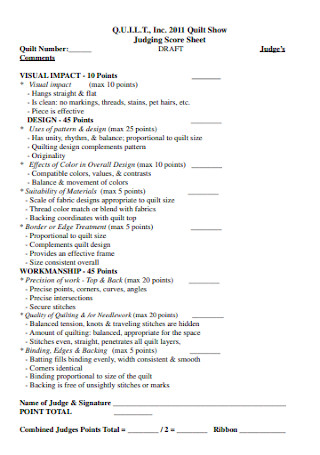
Quilt Show Judging Score Sheet
download now -
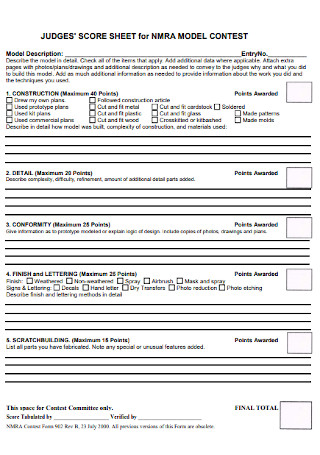
Sample Judges Score Sheet for Model Contest
download now -
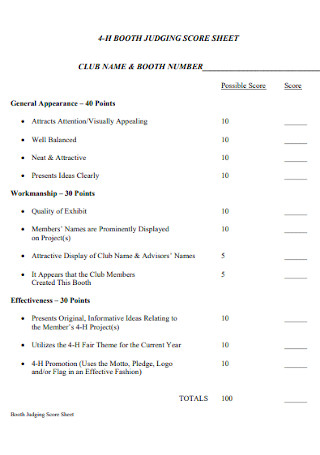
Booth Judging Score Sheet
download now -

Crop Judging Score Sheet
download now -
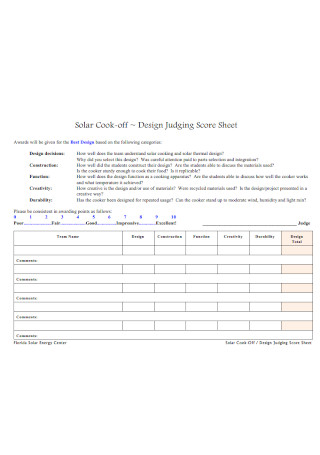
Cook Judging Score Sheet
download now -
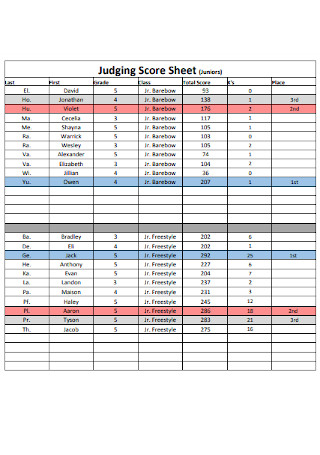
Juniors Judging Score Sheet
download now -
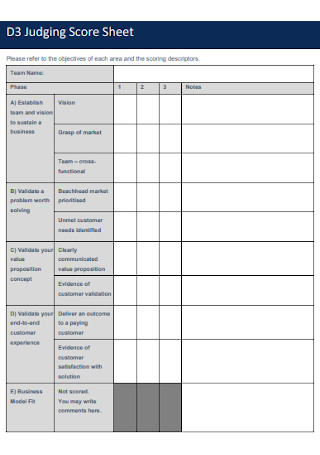
Sample Judging Score Sheet Example
download now -
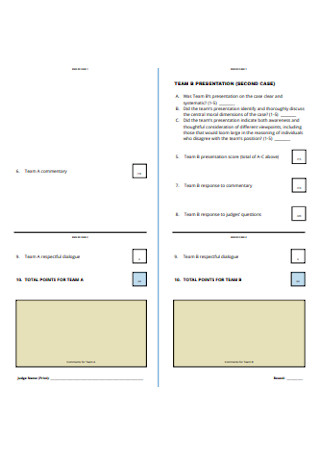
School Parade Judging Score Sheet
download now -
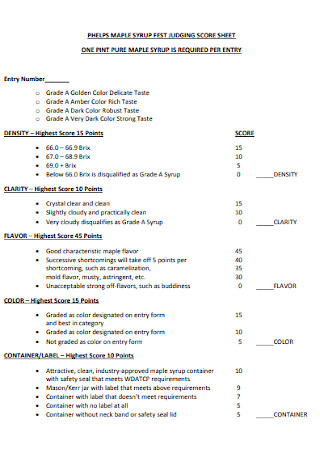
Fest Judging Score Sheet
download now -

Project Judging Score Sheet
download now -
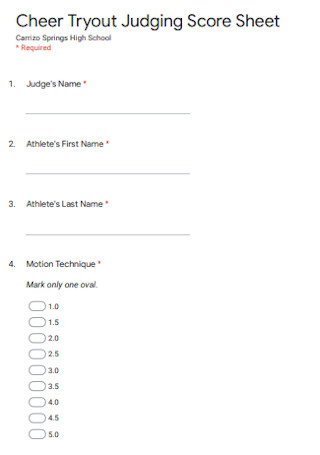
Cheer Tryout Judging Score Sheet
download now -
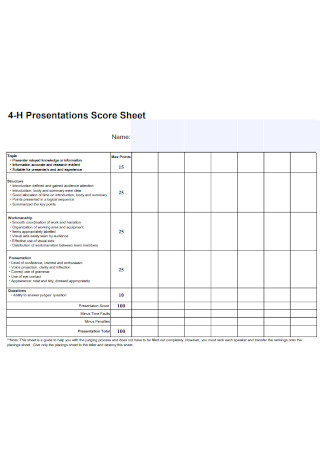
Presentations Score Sheet
download now -
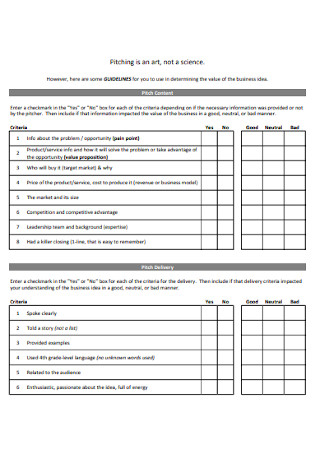
Business Judging Scoring Sheet
download now -
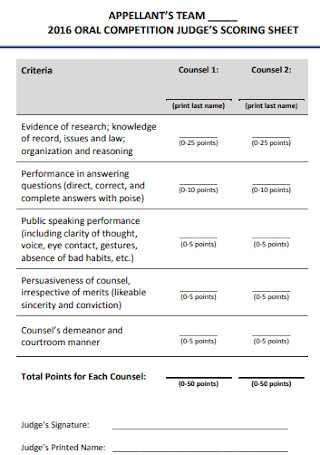
Competition Judges Score Sheet
download now -
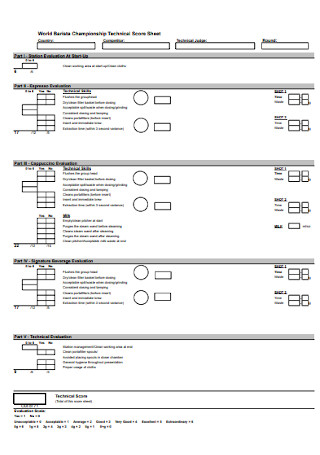
Championship Technical Judges Score Sheet
download now -
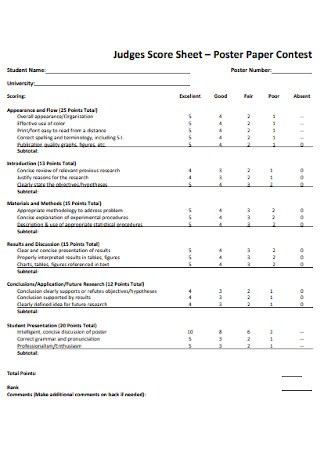
Poster Judges Score Sheet
download now -
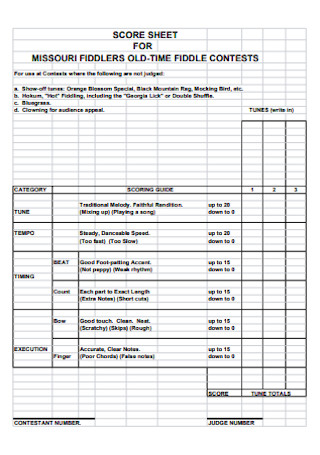
Fiddle Judging Score Sheet
download now -
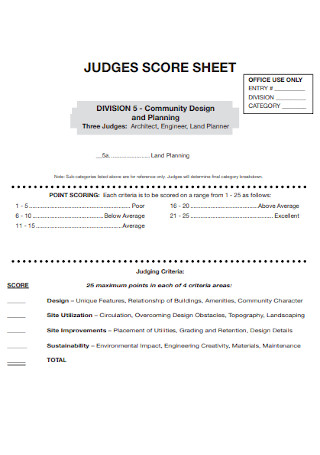
Award Judges Score Sheet
download now
FREE Judging Score Sheet s to Download
Judging Score Sheet Format
Judging Score Sheet Samples
What Is a Judging Score Sheet?
What Are the Elements of a Judging Score Sheet?
How to Make a Judging Score Sheet
What are the benefits of preparing judging score sheets?
How do you calculate judging scores?
What does judging criteria mean?
What are the Criteria for Judging?
What are the Criteria for Judging a Project?
What are Models Judged On?
Why is Judging Criteria Important?
What are the 4 Criteria by Which a Project can be Judged a Success?
What is Judging Method?
What are Some Shortcuts in Judging People?
How Do You Calculate Judge Score?
What is the Scoring Method?
What is Judging Righteously?
What is Judging Value?
What Should You Look for When Judging a Model?
How to Write Judging Criteria?
Is Judging and Judgment the Same?
Download Judging Score Sheet Bundles
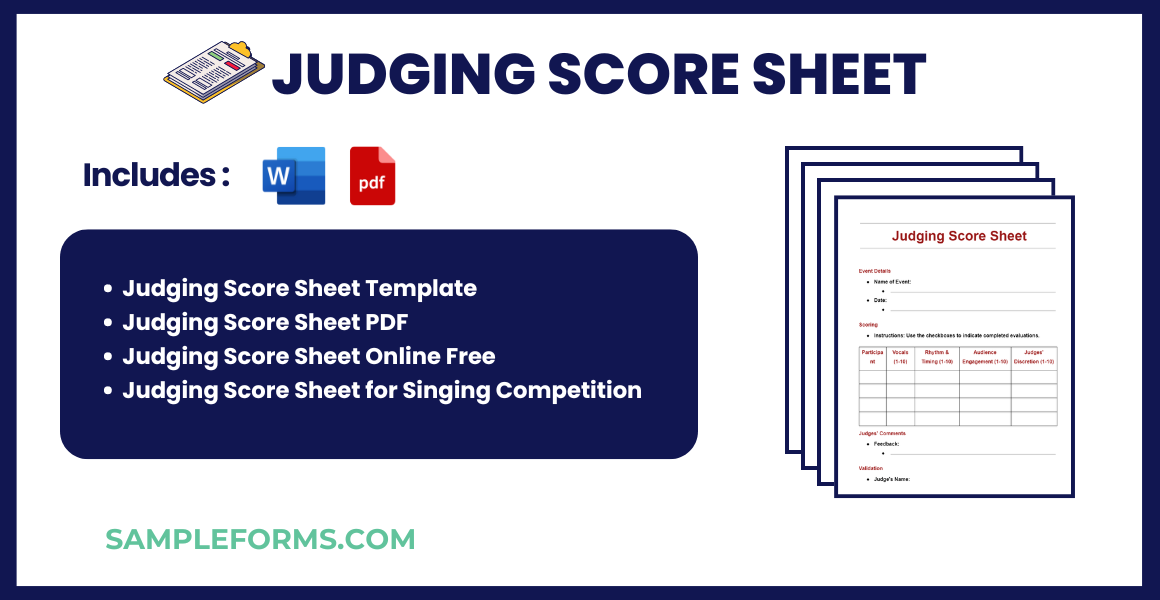
Judging Score Sheet Format
Competition Details
- Event Name: Name of the event or competition.
- Date: Date of the event.
Participant Information
- Participant Name: Name of the participant or team.
- Entry Number: Assigned number to the participant or team.
Scoring Criteria
- Criteria 1, 2, 3, etc.: List each criterion used to judge the entries.
- Score Range: Define the score range for each criterion (e.g., 1-10).
Judges’ Section
- Scores: Space for entering scores for each criterion.
- Comments: Area for judges to write any remarks or feedback.
Summary
- Total Score: Space to tally the scores.
- Judge’s Signature: Signature of the judge.
- Date: Date of scoring.
What Is a Judging Score Sheet?
A judging score sheet is a document used by judges to record scores for participants during a competition. It helps in the fair and transparent assessment of each entry based on set criteria, such as performance, creativity, or accuracy. These sheets are structured to ensure each judge’s decision contributes equally to the final outcome, promoting fairness and objectivity in competitive environments. Typically, score sheets are tailored to the nature of the competition, ensuring that all relevant aspects of the performance are evaluated

Based on a survey, the top five most popular talent shows ever are The Voice, Britain’s Got Talent, America’s Got Talent, The X Factor (UK), and Dancing with the Stars.
Also, Statista reported that 3.82 million Americans from six years old and up participated in cheerleading in 2017.
Why Are Judging Score Sheets Important?
Judging score sheets are vital mainly for evaluation purposes. Without such documents, it will be hard to decide carefully and fairly on whoever wins and loses in contests. The sheet contains the criteria, list of contestants, and other elements in judging properly, so it should not be absent. Moreover, the forms are necessary for documentation. When the judges are done evaluating and scoring, other people might want to know what each judge has inputted in the sheets. Thus, it will be easy to tell if there was anything wrong in the document or discover what scores and comments the contestants received. You also browse our Evaluation Sheet
Furthermore, judging score forms benefit many fields. Whether the plan is to evaluate a dance competition, pageant, science fair, speech, motorcycle show, or anything else, the scoring sheets are useful. But, there are appropriate score sheets for each type of event. You would not use the scoring form meant for a singing competition in a fashion show contest anyway. And most importantly, competitions run successfully and quickly. Some judges could be confused about what criteria to observe while choosing the winners, which can be time-consuming. Hence, a pre-formatted template with the outlined criteria helps in judging competitions conveniently. You also browse our Sign Up Sheet / SignSheet
Who Prepares Judging Score Sheets?
Anyone assigned to help judges in the scoring process can prepare the judging score sheet of a competition. That way, all judges would have the same criteria and other significant details in assessing or scoring. If each judge has to create their score sheet, they might not meet in similar terms. For example, judge A could have forgotten to consider a debater’s stage presence in a debate. Meanwhile, judge B correctly scored the debater’s stage presence but failed to consider the debater’s points in an argument. However, do not just let anyone make the sheet. Set some standards too by having someone skilled in developing effective criteria and scoring system. You also browse our Activity Sheet
What Are the Elements of a Judging Score Sheet?
While the judging score sheet’s meaning and purpose are already clear, are you already familiar with what that sheet contains? Indeed, you can use the document for different applications, but there are common elements found in most scoring forms. What are they? The following are the typical elements to see inside a standard judging score sheet:
How to Make a Judging Score Sheet
Judging can be easy, but it can also put a lot of pressure and work on the judges. Take cheerleading, for example. A 2017 report confirmed that 3.82 million Americans from six years old and above participated in cheerleading. So, a lot of participants might have joined in a cheerleading competition. Thus, more candidates to judge will be done. And identifying who is the best among the best from many competitors takes some work. So, judging score sheets exist to help lessen the struggle in scoring. And to create the sheet itself, please follow these simple steps on making an acceptable judging score sheet:
Step 1: Introduce the Judging Score Sheet
You already know that a title is important in the sheet, as discussed earlier. So, introduce what the judging score sheet is about. A brief introductory statement helps the judges or scorers receive a refresher on what to do with the score sheet. The introduction should inform the event’s purpose, scoring mechanisms, and instructions. Make it to the point where every judge will not have to ask further questions using the document. You also browse our Data Collection Sheet
Step 2: Add the Judging Score Sheet’s Elements
Recall those elements of a judging score sheet that were introduced before. From the title down to the comments, they must be inserted into the form one by one. Those facets make up a complete score sheet anyway. But, do not just insert randomly. Be sure the appropriate elements, or the ones fit for the event, will be used in the form. The elements even create categories, so scorers already know which details signify the criteria, scores, etc. You also browse our Interview Sheet
Step 3: Observe an Organized Format
Never forget to deal with the scoring document’s format. Maybe you just added all the elements without bothering to arrange them. Of course, a sense of organization in presenting the details cannot be ignored. Also, have you tried editing the format of our sample judging score sheet templates already? Explore the templates by changing their design, style, and format until all your preferences will be followed. You also browse our Approval Sheet
Step 4: Be Specific
Reread all your content if you were already specific enough in the statements. A common error overlooked by some people who make the score sheet is writing long sentences when they could be shortened to be more specific. In the criteria, maybe you were too broad in stating to score a contestant’s showmanship. Showmanship can refer to many things. Are you referring to the participant’s poise, enjoyment, confidence, or other aspects included in showmanship? Specify it so judges will not have to guess the meaning. You also browse our Balance Sheet
Step 5: Keep It Easy
The last thing scorers want is to fill out forms that are complicated to understand and are not user-friendly. Work hard in making the experience to fill out the sheets in a hassle-free experience instead. A tip is to provide instructions so judges would know how to work on the form. Next, avoid using complicated words, even though they sound fancy. The key is to keep things understandable, not just impress with your vocabulary. Conduct an assessment checklist to check if the output is giving a simple experience. If not, then it tells you to improve the sheet.
What are the benefits of preparing judging score sheets?
Many benefits are associated with making a judging score sheet. Examples include deciding fairly in tallying scores and saving time and effort in judging. And with sample templates available, you need not start from scratch. Just fill in what is missing in the sheet to complete it. You also browse our Media Fact Sheet
How do you calculate judging scores?
In standard, every judge’s score is calculated by scaling. Scale by having zero mean and one standard deviation. The raw score is also subtracted by the average score, which will later be divided by its corresponding standard deviation. After standardizing every judge’s scores, calculations for the average score follow. Although that is generally used, scoring systems may differ according to the rules given in an event. You also browse our Run Sheet
What does judging criteria mean?
Judging criteria refer to the pointers or tailored elements that a set of judges will evaluate from a contestant list. And they are vital to ensure the best and most deserving contestant wins in a competition. You also browse our Equipment Maintenance Log Sheet
What are the Criteria for Judging?
Establishing clear criteria for judging ensures transparency and fairness in competitive settings.
- Performance: Assessment of the effectiveness and quality of the presentation or task.
- Originality: Evaluating the uniqueness and creativity of the entry.
- Skill Level: Determining the technical skill and precision demonstrated.
- Compliance with Rules: Ensuring all guidelines and rules are followed, similar to a Baseball Scoresheet.
- Overall Impact: Judging the overall effect and audience response to the entry. You also browse our Client Information Sheet
What are the Criteria for Judging a Project?
Judging a project involves several specific criteria that reflect its complexity and purpose.
- Scope and Objectives: Clarity and achievement of the project’s goals.
- Innovation and Creativity: Original solutions and creative approaches used.
- Execution: Quality of the work and implementation of the project plan.
- Impact: The effect of the project on its target audience or sector, akin to metrics on a Vendor Scorecard.
- Sustainability: Long-term viability and efficiency of the project outcomes. You also browse our Call Sheet
What are Models Judged On?
Models in competitions are evaluated based on criteria that highlight their professionalism and presentation.
- Aesthetics: Visual appeal and overall presentation.
- Pose and Walk: Mastery of runway techniques and poise.
- Attire: Appropriateness and fitting of the attire for the occasion.
- Marketability: Potential to represent brand or product effectively.
- Professionalism: Behavior and interaction with judges and audience, documented on a Bowling Score Sheet.
Why is Judging Criteria Important?
Judging criteria are essential to ensure fairness, objectivity, and consistency in competitions.
- Standardization: Provides a uniform standard by which all entries are evaluated.
- Fairness: Ensures all participants are judged by the same standards.
- Transparency: Makes the judging process clear to all participants and observers.
- Feedback: Offers constructive feedback to participants, as seen in a Scholarship Score Sheet.
- Decision Making: Facilitates easier and more defensible decision-making by judges.
What are the 4 Criteria by Which a Project can be Judged a Success?
A project is generally considered successful if it meets several key criteria.
- Completion on Time: Finished within the original timeline specified.
- Budget Adherence: Completed without exceeding the budgeted cost.
- Quality Standards: Meets or exceeds the quality standards set at the project’s inception.
- Stakeholder Satisfaction: Achieves or surpasses the expectations of stakeholders, similar to outcomes tracked on Professional Balanced Scorecard.
What is Judging Method?
The judging method refers to the systematic approach used to evaluate entries in a competition or review.
- Point System: Assigning numerical values to different aspects of the entry.
- Ranking System: Ordering entries from best to worst based on specific criteria.
- Consensus Building: Judges discuss to reach a mutual agreement on each entry.
- Feedback Loops: Incorporating feedback for continuous improvement of the entry.
- Documentation: Recording scores and comments meticulously on a Log Sheet.
What are Some Shortcuts in Judging People?
While not often recommended, there are common shortcuts used in quickly judging people.
- First Impressions: Judging based on the initial appearance or interaction.
- Stereotypes: Relying on generalized beliefs about groups to form judgments.
- Body Language: Interpreting someone’s body language to gauge their confidence or truthfulness.
- Word of Mouth: Basing opinions on what is heard from others.
- Past Experiences: Using personal or second-hand experiences to prejudge someone’s behavior, similar to notations on an Attendance Sheet.
How Do You Calculate Judge Score?
To calculate a judge’s score, tally points assigned to each criterion, ensuring consistency and accuracy, much like a Price List and Sheet.
What is the Scoring Method?
The scoring method typically involves assigning numerical values to predefined criteria, summarizing results in an organized format like a Work Experience Sheet.
What is Judging Righteously?
Judging righteously means assessing fairly and ethically, without personal bias or prejudice, ensuring decisions are grounded in truth and fairness, akin to maintaining an Information Sheet.
What is Judging Value?
Judging value involves assessing the merit or worth of something based on established standards and benchmarks, similar to evaluations performed using a Cost Sheet.
What Should You Look for When Judging a Model?
When judging a model, consider appearance, posture, professionalism, adaptability to styles, and audience engagement, elements that might be summarized on a Data Sheet.
How to Write Judging Criteria?
Writing judging criteria involves clearly defining measurable standards and expectations for each category to ensure transparent and fair evaluation, as detailed on a Fact Sheet.
Is Judging and Judgment the Same?
While closely related, judging refers to the process of making assessments, whereas judgment is the final decision or opinion formed, similar to entries on a Potluck Sign-up Sheet.
Judging score sheets are invaluable in competitions as they provide a standardized method for evaluating participants. This article explores the different types of score sheets, how to effectively implement them, and the importance of maintaining consistency in scoring. Whether for a culinary contest, a dance competition, or a medical review like a Blood Pressure Log Sheet, a well-designed score sheet can significantly enhance the judging process by ensuring clarity, fairness, and detailed feedback for all entries.


